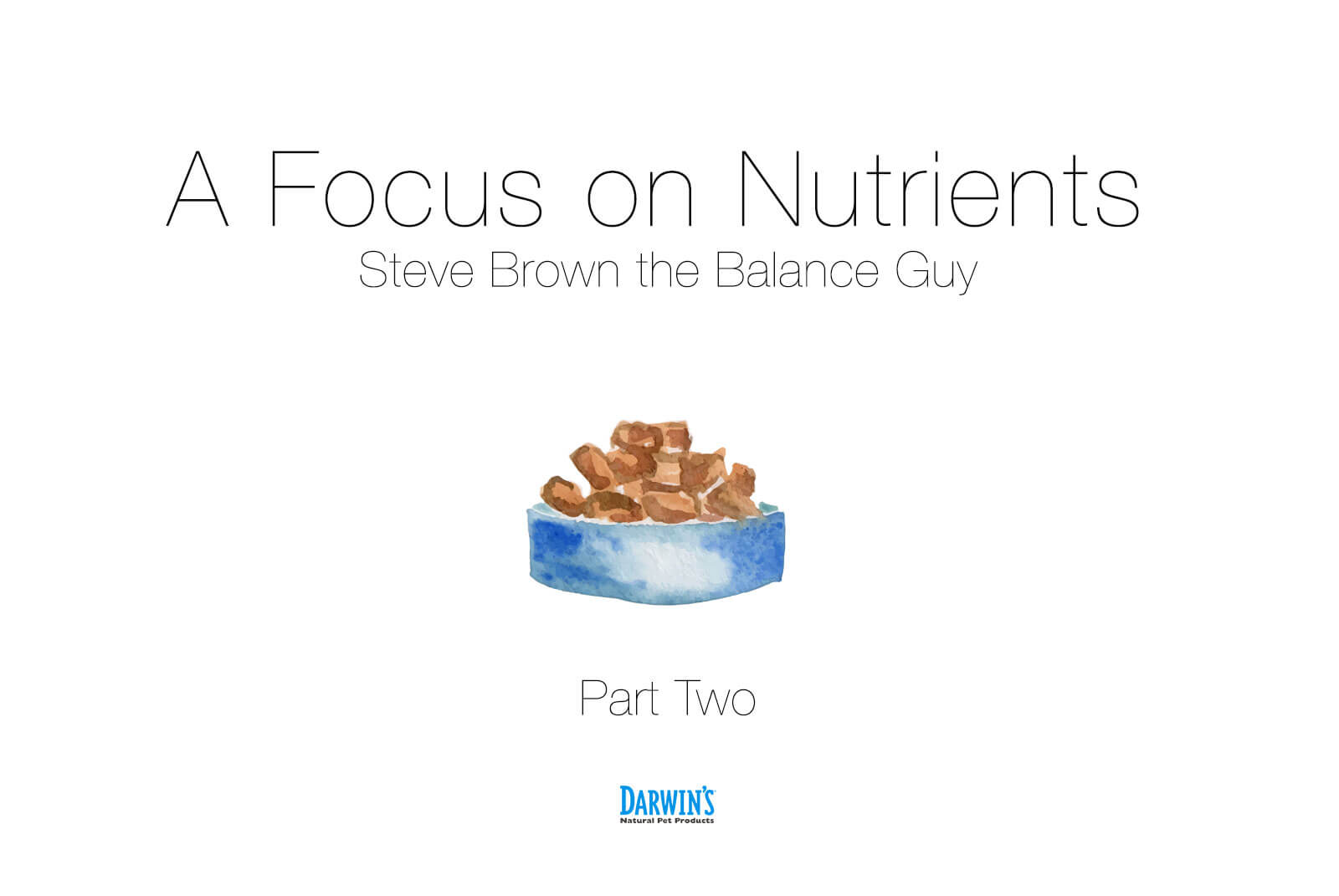Focus On Nutrients: Part 2
8/9/16


Who should read the focus on nutrients blogs? Anyone who cares about nutrition for their dog or cat. Essential nutrients are those that the dog or cat must consume in their diet. Otherwise, disease can result.
Who should read Focus on Nutrients: Part 2?
Veterinarians with clients who feed homemade or commercial raw meat-based diets, every human who makes her own meat-based dog and cat foods, commercial raw food feeders who want a deeper understanding of what makes a great food should read up on nutrition. Also, dry, canned, raw, freeze-dried, and dehydrated food feeders seeking to boost specific nutrients with whole foods benefit from educating themselves.
Common Mistakes With Raw Diets
The major mistake made in many commercial and homemade raw diets is the use of fatty meats, often to save money. The use of fatty meats can result in protein deficiencies, especially for puppies and kittens, exceeding safe upper limits for total fat when compared to AAFCO, FEDIAF, NRC, and ancestral standards and pro-inflammatory amounts of omega-6 fatty acids in chicken foods.
We start with the macronutrients; nutrients often provided in large amounts: proteins, fats, and carbohydrates, which includes fiber. Of course, one of the biggest problems of most dry food is the use of inexpensive carbohydrates to provide the majority of the calories. We’ll then look at the micronutrients: essential nutrients needed in small amounts, the vitamins and minerals, in order of those most likely to be deficient, meeting neither scientific minimums nor ancestral standards. Micronutrients are often deficient in homemade prey model diets. They are also often insufficient in calcium and especially phosphorus, needed for growth and reproduction stages, manganese, iodine, vitamins D, and E, and zinc.
How To Correct These Mistakes
You’ll correct these mistakes by using whole foods whenever possible. We suggest adding whole foods to boost seven or more different nutrients. You must add foods that provide the most nutrients with the fewest calories, otherwise, and I’ve seen this suggested, one can add 3000 kcal to boost a few nutrients for a 1000 kcal diet (A typical 40-pound dog eats about 1,000 kcal per day.). Pay attention to calories.
As examples, we will build two complete and balanced (AAFCO and FEDIAF compliant) adult canine recipes: one using ruminant meats, the other using bone-in poultry. Step by step, you’ll see how it’s done. We will also provide guidelines on how to add whole foods to provide the necessary nutrients. These are almost the same examples that Dr. Karen Becker and I used in our six sessions at the 2016 American Holistic Veterinary Medical Association annual meeting.
Veterinarians and Raw Feeding
Most clinics have some clients who feed or make their own meat-based raw or cooked foods. Even if you don’t agree with their feeding choices, you owe it to your clients to help make sure the foods they feed are complete and balanced. This is especially true for those clients feeding puppies.
Prey Model Diet and Other Homemade Raw Diet Plans
At several recent webinars, seminars and veterinary conferences I’ve had the opportunity to closely analyze prey model and many homemade raw diet recipes. I advised on how to make these recipes more closely mimic The Ancestral Diet and at least meet minimum American and European nutrient recommendations. Prey model diets are meant to mimic the dogs’ ancestral diet of primarily wild prey.
One can’t just feed parts of domesticated animals and call it a prey model diet because it’s not, for two reasons. First, wild prey is leaner and more mineral and antioxidant-rich with better fat balances than domesticated feed-lot fed animals of the same species. Second, it’s very difficult, even for the largest commercial companies, to get the super mineral rich parts of the animals, such as the hair, wool, feathers, adrenals, pituitary, testes, ovaries, prostate, eyes and so forth.
I will focus on nutrients that are most often deficient or out-of-balance when making prey model diets, 80/10/10 diets, and other feeding plans. I will show you how easy it is to correct these deficiencies using whole foods for adult dogs and cats.
It’s not so easy for puppies and kittens. Formulating excellent diets for reproduction and growth is more difficult and demanding than formulating diets for adults. I highly recommend more study, beyond this series, if you plan to make diets for growth or reproduction.
Commercial Raw Food
As I wrote in the introduction to the series, not all raw foods are well-made. Read this series, and you’ll learn what makes great commercial raw diets. You’ll also learn the answers to questions such as, “Why does Darwin’s add copper to their chicken diets but not to their beef and bison diets?”
Feeders of Dog and Cat Foods Who Want to Boost Specific Nutrients Using Whole Foods
Go to the tables at the end of most of the articles and choose the foods that are most appropriate, usually most nutrient per kcal. For example, if your veterinarian recommends that you boost the manganese content of your puppy food, go to the manganese blog and choose a food with the highest amount of manganese with the least amount of calories (mgs Mn per kcal). Or, to boost the vitamin D content of your fat dog’s diet, choose the foods at the top of the table for the most IUs of vitamin D per calorie.
In most endeavors, success is in the details. Making homemade, prey model or commercial raw dog and cat foods does not deviate from this rule. The intent of the “A Focus on Nutrients” series is to give you the details you need — essential nutrient by essential nutrient, so that you can recommend, make or purchase the best foods for most dogs and cats.
* Steve Brown, Wild Prey vs Domesticated Animals: A Comparison Of Nutrients, Dogs Naturally Magazine, January-February 2015
Focus on Nutrients: Part 1 by Steve Brown
Steve Brown is a dog food formulator, researcher, and author on canine nutrition. In the 1990s he developed one of the leading low-calorie training treats, Charlee Bear® Dog Treats, as well as the first AAFCO-compliant raw dog food. Since 2003 he has focused on research and education. He is the author of two books on canine nutrition (See Spot Live Longer, now in its 8th printing, and Unlocking the Canine Ancestral Diet (Dogwise Publishing, 2010); and a 40-page booklet, See Spot Live Longer the ABC Way.



